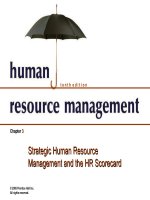Dessler ch 10 managing careers
Bạn đang xem bản rút gọn của tài liệu. Xem và tải ngay bản đầy đủ của tài liệu tại đây (468.26 KB, 31 trang )
Gary Dessler
tenth edition
Chapter 10 Appendix
Part 3 Training and Development
Managing Careers
© 2005 Prentice Hall Inc.
All rights reserved.
PowerPoint Presentation by Charlie Cook
The University of West Alabama
After studying this chapter,
you should be able to:
1. Compare employers’ traditional and career
planning-oriented HR focuses
2. Explain the employee’s manager’s and employer’s
career development roles
3. Describe the issues to consider when making
promotion decisions
4. Describe the methods for enhancing diversity
through career management
5. Answer the question: How can career development
foster employee commitment?
© 2005 Prentice Hall Inc. All rights reserved.
10–2
10–2
The Basics of Career Management
Career
– The occupational positions a person has had over
many years.
Career management
– The process for enabling employees to better
understand and develop their career skills and
interests, and to use these skills and interests
more effectively.
Career development
– The lifelong series of activities that contribute to a
person’s career exploration, establishment,
success,
and
fulfillment.
© 2005
Prentice
Hall
Inc.
10–
All rights reserved.
3
The Basics of Career Management
Career planning
– The deliberate process through which someone
becomes aware of personal skills, interests,
knowledge, motivations, and other characteristics;
and establishes action plans to attain specific
goals.
Careers today
– Careers are no simple progressions of employment
in one or two firms with a single profession.
– Employees now want to exchange performance for
training, learning, and development that keep
them marketable.
© 2005 Prentice Hall Inc.
All rights reserved.
10–4
Traditional Versus Career Development Focus
© 2005 Prentice Hall Inc.
All rights reserved.
Source: Adapted from Fred L. Otte and Peggy G. Hutcheson, Helping
Employees Manage Careers (Upper Saddle River, NJ: Prentice Hall, 1992), p.
10.
Table 10–1
10–5
Employee Career
Development
Plan
© 2005 Prentice Hall Inc.
All rights reserved.
Source: Reprinted with permission of the publisher, HRnext.com Copyright HRnext.com, 2003.
10–
6
Figure 10–1
The Individual
• Accept responsibility for your own career.
• Assess your interests, skills, and values.
• Seek out career information and resources.
• Establish goals and career plans.
• Utilize development opportunities.
• Talk with your manager about your career.
• Follow through on realistic career plans.
The Manager
Roles in Career
Development
• Provide timely performance feedback.
• Provide developmental assignments and support.
• Participate in career development discussions.
• Support employee development plans.
The Organization
• Communicate mission, policies, and procedures.
• Provide training and development opportunities.
• Provide career information and career programs.
©
2005
Prentice
Hall
Inc.
• Offer
a variety
of career
options.
All rights reserved.
Source: Fred L. Otte and Peggy G. Hutcheson,
Helping Employees Manage Careers (Upper
Saddle River, NJ: Prentice Hall, 1992), p. 56.
Table 10–2
10–7
Choosing a Mentor
Choose an appropriate potential mentor.
Don’t be surprised if you’re turned down.
Be sure that the mentor understands what
you expect in terms of time and advice.
Have an agenda.
Respect the mentor’s time.
© 2005 Prentice Hall Inc.
All rights reserved.
10–8
The Employer’s Role in Career
Development
Realistic job previews
Challenging first jobs
Career-oriented appraisals
Job rotation
Mentoring
Networking and interactions
© 2005 Prentice Hall Inc.
All rights reserved.
10–9
Innovative Corporate Career
Development Initiatives
Provide each employee with an individual budget.
Offer on-site or online career centers.
Encourage role reversal.
Establish a “corporate campus.”
Help organize “career success teams.”
Provide career coaches.
Provide career planning workshops
Utilize computerized on- and offline career
development programs
Establish a dedicated facility for career development
© 2005 Prentice Hall Inc.
10–
All rights reserved.
10
Sample Agenda—
Two-Day Career
Planning
Workshop
© 2005 Prentice Hall Inc.
All rights reserved.
Source: Fred L. Otte and Peggy Hutcheson, Helping
Employees Manage Careers (Upper Saddle River, NJ:
Prentice Hall, 1992), pp. 22–23. In addition to career
development training and follow-up support, First USA
Bank has also outfitted special career development
facilities at its work sites that employees can use on
company time. These contain materials such as career
assessment and planning tools.
10–
11
Figure 10–2
Managing Promotions
Making promotion decisions
– Decision 1: Is Seniority or Competence the Rule?
– Decision 2: How Should We Measure Competence?
– Decision 3: Is the Process Formal or Informal?
– Decision 4: Vertical, Horizontal, or Other?
© 2005 Prentice Hall Inc.
All rights reserved.
10–
12
Managing Transfers
Employees’ reasons for desiring transfers
–
–
–
–
Personal enrichment and growth
More interesting jobs
Greater convenience (better hours, location)
Greater advancement possibilities
Employers’ reasons for transferring employees
– To vacate a position where an employee is no
longer needed.
– To fill a position where an employee is needed.
– To find a better fit for an employee within the firm.
– To boost productivity by consolidating positions.
© 2005 Prentice Hall Inc.
10–
All rights reserved.
13
Enhancing Diversity through Career
Management
Sources of bias and discrimination in
promotion decisions
– Having few people of color employed in the hiring
department
– The “old-boy network” of informal friendships
– A lack of women mentors
– A lack of high-visibility assignments and
developmental experiences (glass ceiling)
– A lack of company role models for members of the
same racial or ethnic group
Inflexible
and career tracks
© –2005
Prenticeorganizations
Hall Inc.
10–
All rights reserved.
14
Enhancing Women’s and Minorities’
Prospects
Eliminate institutional barriers
Improve networking and mentoring
Eliminate the glass ceiling
Institute flexible schedules and career tracks
© 2005 Prentice Hall Inc.
All rights reserved.
10–
15
Career Management and Employee
Commitment
The “New Psychological Contract”
– Old contract: “Do your best and be loyal to us,
and we’ll take care of your career.”
– New contract: “Do your best for us and be loyal
to us for as long as you’re here, and we’ll provide
you with the developmental opportunities you’ll
need to move on and have a successful career.”
© 2005 Prentice Hall Inc.
All rights reserved.
10–
16
Career Management and Employee
Commitment
Commitment-oriented career development
efforts
– Career development programs
• Career workshops that use vocational guidance tools
(including a computerized skills assessment program
and other career gap analysis tools) to help employees
identify career-related skills and the development needs
they possess.
– Career-oriented appraisals
• Provide the ideal occasion to link the employee’s
performance, career interests, and developmental needs
into a coherent career plan.
© 2005 Prentice Hall Inc.
All rights reserved.
10–
17
Retirement
Retirement
– The point at which one gives up one’s work,
usually between the ages of 60 and 65.
Preretirement practices
– Explanation of Social Security benefits
– Leisure time counseling
– Financial and investment counseling
– Health counseling
– Psychological counseling
– Counseling for second careers
– Counseling for second careers inside the company
© 2005 Prentice Hall Inc.
10–
All rights reserved.
18
Sample
Performance
Review
Development
Plan
© 2005 Prentice Hall Inc.
All rights reserved.
Source: Business & Legal Reports, Inc.
10–
19
Figure 10–3
HR Scorecard
for Hotel Paris
International
Corporation*
© 2005 Prentice Hall Inc.
All rights reserved.
Note: *(An abbreviated example showing selected
HR practices and outcomes aimed at implementing
the competitive strategy, “To use superior guest
services to differentiate the Hotel Paris properties
and thus increase the length of stays and the return
rate of guests and thus boost revenues and
profitability”)
10–
20
Figure 10–4
Key Terms
career
career management
career development
career planning
career planning and
development
reality shock
job rotation
mentoring
promotions
transfers
retirement
preretirement counseling
© 2005 Prentice Hall Inc.
All rights reserved.
career cycle
growth stage
exploration stage
establishment stage
trial substage
stabilization substage
midcareer crisis substage
maintenance stage
decline stage
career anchors
10–
21
Gary Dessler
tenth edition
Chapter 10 Appendix
Part 3 Training and Development
Managing Your Career
© 2005 Prentice Hall Inc.
All rights reserved.
PowerPoint Presentation by Charlie Cook
The University of West Alabama
Identify Your Career Stage
Growth stage
Exploration stage
Establishment stage
– Trial substage
– Stabilization substage
– Midcareer crisis substage
Maintenance Stage
Decline Stage
© 2005 Prentice Hall Inc.
All rights reserved.
10–
23
Identify Your Occupational Orientation
Realistic orientation
Investigative orientation
Social orientation
Conventional orientation
Enterprising orientation
Artistic orientation
© 2005 Prentice Hall Inc.
All rights reserved.
10–
24
Choosing an Occupational Orientation
© 2005 Prentice Hall Inc.
All rights reserved.
10–
25
Figure 10–A1









